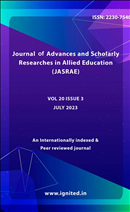Nonlinear Fractio Al Partial Differential Equations: A new Analytical Technique for Solving
DOI:
https://doi.org/10.29070/z440pw75Keywords:
Nonlinear fractional partial differential equations, Analytical techniques, Fractional calculusAbstract
In many branches of science and engineering, nonlinear fractional partial differential equations (FPDEs) have shown to be effective instruments for simulating complicated processes. The intrinsic complexity of these equations and the nonlocal nature of fractional derivatives pose challenges to traditional techniques of solving them. In order to overcome these difficulties, this paper presents a brand-new analytical method that offers a practical and quick way to solve nonlinear FPDEs. The suggested approach combines [briefly outline the fundamental techniques, such as the Adomian decomposition and Laplace transform] to get precise results with little computing overhead. The technique's effectiveness and adaptability are shown by a number of examples, which also highlight its potential for broad use in fields including biological systems, fluid dynamics, and financial modelling.
References
Abdeljawad, T. (2015). On conformable fractional calculus. Journal of Computational and Applied Mathematics, 279, 57-66.
Bakkyaraj, T., & Sahadevan, R. (2015). Approximate analytical solution of two coupled time fractional nonlinear Schrodinger equations. International Journal of Applied and Computational Mathematics, 2(1), 113-135.
Das, S., & Kumar, R.(2011). Approximate analytical solutions of fractional gas dynamic equations. Applied Mathematics and Computation, 217(24), 9905-9915.
Ekici, M., Mirzazadeh, M., Eslami, M., Zhou, Q., Moshokoa, S. P., Biswas, A., & Belie, M. (2016). Optical soliton perturbation with fractional-temporal evolution by first integral method with conformable fractional derivatives. Optik - International Journal for Light and Electron Optics, 127(22), 10659-10669.
Harris P.A., GarraR.,(2013), " Analytic solution of nonlinear fractional Burgers type equation lby invariant subspace method", onlinear Studies, 20 471-481.
Hashemi M. S. (2015), " A numerical analysis of Burgers-Poisson equation using Variational Iteration Method", Physica A: Statistical Mechanics and its Applications, 417, 141-149.
Jumarie G., (2006), "Lagrange characteristic method for solving a class of nonlinear partial differential equations of fractional order'', Applied Mathemat- ics Letters 19.9, 873-880.
Khalil, R., Al Horani, M., Yousef, A., &Sababheh, M. (2014). A new definition of fractional derivative. Journal of Computational and Applied Mathematics, 264, 65-70.
Ma W. X.,(2012), "A refined invariant subspace method and applications to evolution equations.", Science China Mathematics, 55, 1769-1778.
Sahadevan R., Bakkyaraj T., (2015), ''Invarianv subspace method and exact solutions of certain nonlinear time fractional partial differential equations", Fractional calculus and applied analysis, 18.1, 146-162.
Wu G. C., (2011), ''Lie group classifications and non-differentiable solutions for time fractional Burgers Equation", Communications in Theoretical Physics, 55.6, 1073-1078.
Zhang S., (2008), ''Exact solutions of a KdV equation with variable coeffi- cients via Exp-function method", onlinear Dynamics, 52.1-2, 11-17.











